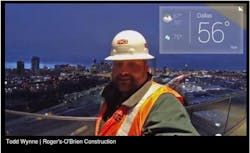BIM 2.0 and Google Glass: Science fiction or coming attractions for a job site near you?
Editor's note: This is a sponsored article. All text and images were provided by the sponsor company.
Not long ago, BD+C asked a dozen of the AEC firms from their BIM Giants list to share their vision of BIM 2.0. The responses ranged from improved mobility solutions allowing multiple people to collaborate within a single model to Robotic Stations leveraging geospatial data for sophisticated field placement of materials.
One CIO mentioned “the rise of virtual reality,” stating that the “integration of BIM with virtual reality technologies is a promising development.” Google Glass was named as a piece of hardware thought to have the potential to bring the field and office together by overlaying model data on real objects and capturing actual field conditions. In April, I mentioned that an architect in Australia is giving augmented reality and Google glass a go. Although I’m a fan of making X-ray vision a reality for the building industry, I’m far more interested in a broader application that can truly help builders communicate better.
On my quest to find a valid use case for Google Glass in construction, I came across a self-proclaimed “nerd for operation in construction,” Todd Wynne with Rogers-O’Brien Construction. Todd is the Operation Technology Specialist (a role that did not exist until he was hired), tasked with finding new and innovative ways to go about the business of construction.
Todd feels that the field is grossly underserved when it comes to technology. He states, “90% of technology available today has been attributed to the office, not the field.” He goes on to liken it to a triangle: “At the top is BIM, QR codes, material tracking, and laser scanning—but the problem is that the rest of the industry is working at the bottom of the pyramid. Pilot programs are starting to make progress in bringing the bottom up, but it’s not enough.” He feels the greatest immediate effect we can have to bridge this gap is to leverage digital documents. Currently they are using iPads and linked PDF documents to communicate project information quickly between the office and the field. “It’s the guy with the wrench, that’s who I’m focusing on.”
Todd has put his passion for innovation into action, supplying all site workers with iPads synced with linked PDF documents. In fact, as of today, Rogers-O’Brien is only 10 iPads away from completing their goal of device saturation. Todd sent me a picture of his towering reminder of his goal to give access to all. But he’s not stopping there – next on his radar is proving how Google Glass can solve inefficiencies found within the building industry today.
Todd applied for Google’s explorer program, submitting a 15-second video and a 50-word description outlining his vision of wearable technology as the wave of the future for construction. Watch Todd's video submission:
Todd sees a world where daily tasks of photographing issues and communicating with designers are done seamlessly and effectively through technology you wear on your body. The field worker of tomorrow will wear safety glasses, a hard hat and clothing that reads body gestures to interact with devices like Google Glass.
As one of 8,000 people around the globe granted a pair of Glass, Todd is already putting the device to the test. He’s used it on multiple jobs doing everything from quality control, in-wall inspections and taking photos of lay-in ceiling to holding impromptu meetings to resolve issues in the field.
One story illustrates why Todd’s vision for the future may not be that far off. Recently when doing a job walk with a project engineer, they came across a sub who questioned them about the flashing on the roof. Since he was wearing his Google Glass, he decided to put his own theory to the test. He called the architect on the phone, but the architect couldn’t grasp the issue well enough to instruct them. So using Google Glass and Google’s live video chat, Todd had the architect “look through my eyes,” directing him to view the issue better. “Now look to the right, pull that flashing back…right there. Okay, this is what you need to do…” Boom, they had their answer in a matter of minutes. The PE was able to issue a confirming RFI rather than a standard RFI, shortening the process by a couple weeks.
Todd is quick to point out that technology today is far from perfect. Construction workers need the glass to be gesture-driven. Between noise interference from the jobsite and gloves worn for safety, voice commands and touch aren’t much help. But it’s clear, Todd is on to something here. I have no doubt he’s going to continue to push the limits, not stopping until he brings BIM 2.0 to a jobsite near you.

